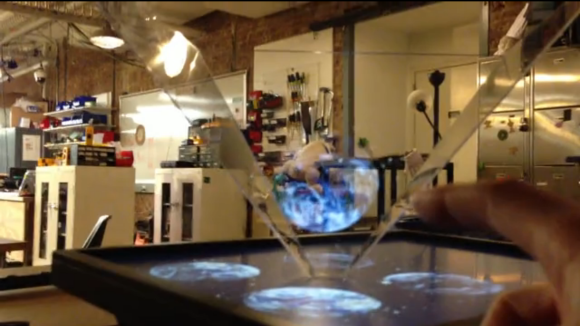
Touch screens are nice — we still can’t live without a keyboard but they suffice when on the go. But it is becoming obvious that the end goal with user interface techniques is to completely remove the need to touch a piece of hardware in order to interact with it. One avenue for this goal is the use of voice commands via software like Siri, but another is the use of 3D processing hardware like Kinect or Leap Motion. This project uses the latter to control the image shown on the 3D display.
[Robbie Tilton] generated a 3D image using Three.js, a JavaScript 3D library. The images are made to appear as if floating in air using a pyramid of acrylic which reflects the light toward the viewer’s eyes without blocking out ambient light in the room. In the past we’ve referred to this as a volumetric display. But [Robbie] points out that this actually uses the illusion called Pepper’s Ghost. It’s not really volumetric because the depth is merely an illusion. Moving your point of view won’t change your perspective unless you go around the corner to the next piece of acrylic. But it’s still a nice effect. See for yourself in the demo after the jump.
[via Dvice]















Okay, so it isn’t volumetric… but why couldn’t it be? It seems this 3d display is displaying four different images projects onto the four sides of a pyramidshape.
So why couldn’t they do a computer generated “stretch panorama” out of the object displaying a full circle view of it on the display all around the base of the “screen”, and then having it projected onto a cone instead of a pyramid?
Just was wondering the same thing. Although it might be difficult to come up with an acrylic cone.
Thought of the same thing aswell when i first learned about peppers ghost, but i don’t think it would work in the context your giving. you’d just get a strange image that can only be viewed from one angle, you wouldn’t be able to rotate around it and see different ‘views’ because the effect depends on a reflection aimed towards you. You can see this effect to make really impressive “holograms” in that disneyland ride haunted mansion, but these are reflections of a 3d animatronic sculpture rather than a flat image onto a flat plane. whens its done like this you could rotate around and its really 3D.
You’d need to set up something really complicated to get a 3D object with this effect, but i thought it through a bit, and i think i’ve figured something out. If you use a pair of twisted nematics for the projector and reflector, and somehow get a high enough refresh rate syncd between them, you could probably “scan” in a lenticular style 3d effect with the polarization where viewing angle would need to be changed. you’d have a limited “angular” resolution on x axis only, but this is already leaps and bounds more “3d” than a 3d display
Just as a note, they’ve changed how they do the Haunted Mansion’s ghosts. Now they do stuff that interacts with the person, i.e. one of the ghosts will take off their head and change it for yours.
not 3d. there is no way you can see any depth with his design. It’s a multi sided 2D projection.
indeed
Awesome build! Well crafted.
For the true 3d effect, you could also use some active shutter glasses and a left/right refresh display. But that takes the fun and beautiful simplicity out of this project.
Really Cool
Yep really cool :) good idea. Would it be possible to replace that pyramide by 3 “transparent” lcd screen (without the backlight)? Like that you will have a bigger surface to play with.